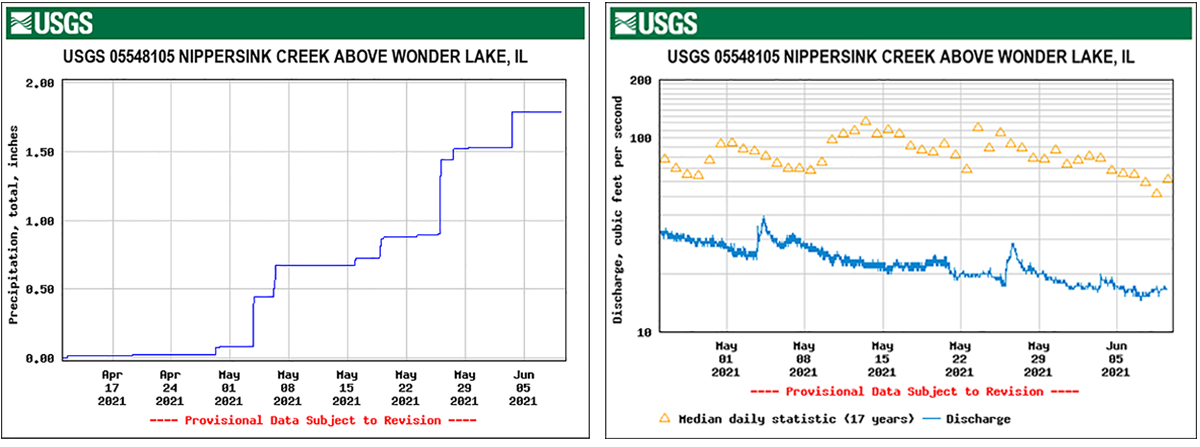1. As everyone knows, most of McHenry County is experiencing a severe drought. Based on long-term averages, over the last two months, the amount of expected rainfall would have been over 8.5 inches. Instead, the USGS rain gage at Thompson Road only recorded 1.75 inches of rain over that two-month period. This lack of rainfall, which is even more extreme in the Nippersink Creek watershed above Wonder Lake, has resulted in the stream flow into Wonder Lake dropping from an average of around 60 cubic feet per second (CFS), to less than 18 CFS. While this reduction in streamflow has not yet caused the lake level to drop below the spillway elevation, a continued lack of rainfall could cause the lake level to drop. If this occurs, lake users will need to exercise caution in shallower areas of the lake.

2. An additional concern resulting from the lack of rainfall and hot temperatures is the potential for algae blooms to occur. Fortunately, the Wonder Lake Dredging Project removed hundreds of tons of nitrogen and phosphorus bound up in the dredged sediment, that could otherwise help fuel a bloom, however, there are still significant amounts of nutrients in the lakebed sediment available as fuel for a bloom. A “normal” algae bloom typically features green algae suspended in the water column, and while it makes the water look less inviting, it is generally not harmful. Given current weather conditions, there is also the potential for an out-break of Harmful Algae Blooms (HABs), such as those that occurred in many lakes across northern Illinois in the hot dry summer of 2012. A HAB algal bloom can be green, blue, red or brown. They can be scummy or look like paint on the surface of the water. More information on HABs can be found on the following page. Representative photos of HABs can be found here: https://www.dec.ny.gov/chemical/81962.html If lake users note anything suspicious, contact the MPOA office.
3. Concerns were raised by boaters about the lack of visibility of O’Brien Shoals North since a dead tree was removed from the island. Thanks to Tony Musel and Ken Shaleen, who volunteered to install some triangle shaped reflectors on the rip-rap collar surrounding the island.
4. The MPOA wishes everyone a happy and safe 4th of July on the lake, and hopes that people enjoy the Venetian Night, Ski Team Show and Fireworks display.
Harmful Algal Blooms (HABs)
Groups of people who experience illness with similar symptoms after swimming in recreational water should contact their local health department for follow up. If you suspect a blue-green algal bloom on your lake or on a lake you have visited, you can report it to the Illinois EPA using the HAB report form. This form captures the environmental event and includes fields for the bloom location, size, and various characteristics like odor and color. Pictures of the bloom may also be uploaded. The HAB report form can be found here.
Harmful Algal Bloom FAQs
What are blue-green algae? Blue-green algae, or cyanobacteria, are photosynthetic bacteria that are a natural part of the aquatic environment. Blue-green algae are often present in Illinois lakes in small or moderate amounts, but can grow and proliferate quickly in warm, fresh water that is rich with nutrients (like nitrogen and phosphorous). This sudden, rapid growth is referred to as an algal “bloom”.
What are harmful algal blooms? Harmful algal blooms (HABs) are blue-green algae blooms that may adversely affect humans, animals, and the environment. In Illinois, blooms typically occur during the warm-weather months of June through September. Blooms may appear as a thick scum layer or green paint on the surface of the water, and can be a variety of colors such as blue, green, or brown. There may also be a foul odor present during a bloom, especially during the warm summer months. The production of toxins is what makes an algal bloom harmful. Microcystin is the most well-known toxin produced during a harmful algal bloom, and it can cause a variety of symptoms by affecting the skin, liver, GI tract, and nervous system. Ingestion, inhalation, or direct contact with contaminated water may cause illness.
What causes harmful algal blooms? Warm water, sunlight, and little wind are ideal conditions for a harmful algal bloom (HAB). If a large amount of nutrients like nitrogen and phosphorus are introduced into the water when conditions are right, a HAB can quickly form. Agricultural or residential fertilizers that contain phosphorus can contribute to the formation of HABs if they are washed into a nearby water body (for example, during a large storm).
What should I do if I see a bloom? It is impossible to tell from a visual inspection whether an algal bloom is toxic. Avoid the water where the bloom is located, and notify the Illinois EPA of a possible HAB event.
- Do not swim or wade through algal scums
- Do not boat, water ski, jet ski, or fish where algal scum is present
- Always shower off with soap and water after swimming in a lake, river, or pond
- Do not let dogs drink, eat, or lick algal scum off their fur
- Wash your dog off with clean water immediately if your dog swims or wades in water during an algal bloom.
